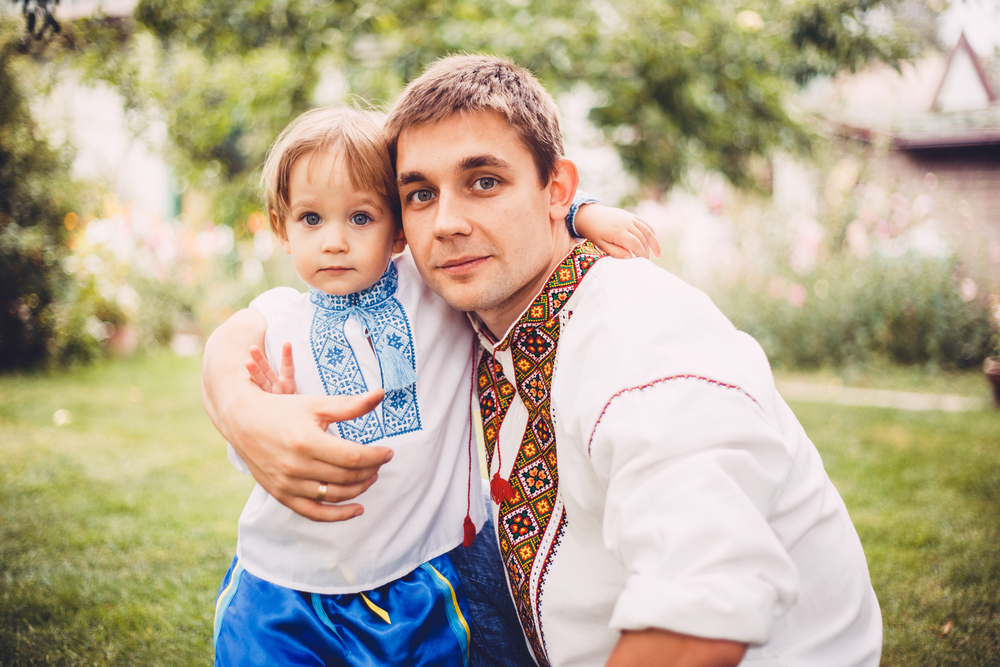Population:
43,952,299
(July 2018 est.)
country comparison to the world:
32
Nationality:
noun:
Ukrainian(s)
adjective:
Ukrainian
Ethnic groups:
Ukrainian 77.8%, Russian 17.3%, Belarusian 0.6%, Moldovan 0.5%, Crimean Tatar 0.5%, Bulgarian 0.4%, Hungarian 0.3%, Romanian 0.3%, Polish 0.3%, Jewish 0.2%, other 1.8%
(2001 est.)
Languages:
Ukrainian (official) 67.5%, Russian (regional language) 29.6%, other (includes small Crimean Tatar-, Moldovan/Romanian-, and Hungarian-speaking minorities) 2.9% (2001 est.)
note: in February 2018, the Constitutional Court ruled that 2012 language legislation entitling a language spoken by at least 10% of an oblast's population to be given the status of "regional language" - allowing for its use in courts, schools, and other government institutions - was unconstitutional, thus making the law invalid; Ukrainian remains the country's only official nationwide language
Religions:
Orthodox (includes Ukrainian Autocephalous Orthodox (UAOC), Ukrainian Orthodox - Kyiv Patriarchate (UOC-KP), Ukrainian Orthodox - Moscow Patriarchate (UOC-MP)), Ukrainian Greek Catholic, Roman Catholic, Protestant, Muslim, Jewish
(2013 est.)
note: Ukraine's population is overwhelmingly Christian; the vast majority - up to two-thirds - identify themselves as Orthodox, but many do not specify a particular branch; the UOC-KP and the UOC-MP each represent less than a quarter of the country's population, the Ukrainian Greek Catholic Church accounts for 8-10%, and the UAOC accounts for 1-2%; Muslim and Jewish adherents each compose less than 1% of the total population
Age structure:
0-14 years:
15.95%
(male 3,609,386 /female 3,400,349)
15-24 years:
9.57%
(male 2,156,338 /female 2,047,821)
25-54 years:
44.03%
(male 9,522,108 /female 9,831,924)
55-64 years:
13.96%
(male 2,638,173 /female 3,499,718)
65 years and over:
16.49%
(male 2,433,718 /female 4,812,764)
(2018 est.)
population pyramid:
Europe ::
Ukraine
Print
This is the population pyramid for Ukraine. A population pyramid illustrates the age and sex structure of a country's population and may provide insights about political and social stability, as well as economic development. The population is distributed along the horizontal axis, with males shown on the left and females on the right. The male and female populations are broken down into 5-year age groups represented as horizontal bars along the vertical axis, with the youngest age groups at the bottom and the oldest at the top. The shape of the population pyramid gradually evolves over time based on fertility, mortality, and international migration trends. For additional information, please see the entry for Population pyramid on the Definitions and Notes page under the References tab.
Dependency ratios:
total dependency ratio:
44.8
(2015 est.)
youth dependency ratio:
21.8
(2015 est.)
elderly dependency ratio:
23
(2015 est.)
potential support ratio:
4.3
(2015 est.)
note: data include Crimea
Median age:
Population growth rate:
0.04%
(2018 est.)
country comparison to the world:
187
Birth rate:
10.1 births/1,000 population
(2018 est.)
country comparison to the world:
190
Death rate:
14.3 deaths/1,000 population
(2018 est.)
country comparison to the world:
6
Net migration rate:
0 migrant(s)/1,000 population
(2017 est.)
country comparison to the world:
100
Population distribution:
densest settlement in the eastern (Donbas) and western regions; noteable concentrations in and around major urban areas of Kyiv, Kharkiv, Donets'k, Dnipropetrovs'k, and Odesa
Urbanization:
urban population:
69.4% of total population
(2018)
rate of urbanization:
-0.33% annual rate of change
(2015-20 est.)
Major urban areas - population:
2.957 million KYIV (capital), 1.436 million Kharkiv, 1.01 million Odesa, 969,000 Dnipropetrovsk, 919,000 Donetsk
(2018)
Sex ratio:
at birth:
1.06 male(s)/female
(2017 est.)
0-14 years:
1.06 male(s)/female
(2017 est.)
15-24 years:
1.05 male(s)/female
(2017 est.)
25-54 years:
0.96 male(s)/female
(2017 est.)
55-64 years:
0.75 male(s)/female
(2017 est.)
65 years and over:
0.5 male(s)/female
(2017 est.)
total population:
0.86 male(s)/female
(2017 est.)
Mother's mean age at first birth:
Maternal mortality rate:
24 deaths/100,000 live births
(2015 est.)
country comparison to the world:
125
Infant mortality rate:
total:
7.7 deaths/1,000 live births
(2018 est.)
male:
8.6 deaths/1,000 live births
(2018 est.)
female:
6.7 deaths/1,000 live births
(2018 est.)
country comparison to the world:
157
Life expectancy at birth:
total population:
72.4 years
(2018 est.)
male:
67.7 years
(2018 est.)
female:
77.4 years
(2018 est.)
country comparison to the world:
148
Total fertility rate:
1.55 children born/woman
(2018 est.)
country comparison to the world:
190
Contraceptive prevalence rate:
Health expenditures:
7.1% of GDP
(2014)
country comparison to the world:
80
Physicians density:
3 physicians/1,000 population
(2014)
Hospital bed density:
8.8 beds/1,000 population
(2013)
Drinking water source:
improved:
urban:
95.5% of population
rural:
97.8% of population
total:
96.2% of population
unimproved:
urban:
4.5% of population
rural:
2.2% of population
total:
3.8% of population
(2015 est.)
Sanitation facility access:
improved:
urban:
97.4% of population
(2015 est.)
rural:
92.6% of population
(2015 est.)
total:
95.9% of population
(2015 est.)
unimproved:
urban:
2.6% of population
(2015 est.)
rural:
7.4% of population
(2015 est.)
total:
4.1% of population
(2015 est.)
HIV/AIDS - adult prevalence rate:
0.9%
(2017 est.)
country comparison to the world:
49
HIV/AIDS - people living with HIV/AIDS:
240,000
(2017 est.)
country comparison to the world:
24
HIV/AIDS - deaths:
9,000
(2017 est.)
country comparison to the world:
21
Obesity - adult prevalence rate:
24.1%
(2016)
country comparison to the world:
61
Education expenditures:
5.9% of GDP
(2014)
country comparison to the world:
41
Literacy:
definition:
age 15 and over can read and write
(2015 est.)
total population:
99.8%
(2015 est.)
male:
99.8%
(2015 est.)
female:
99.7%
(2015 est.)
School life expectancy (primary to tertiary education):
total:
15 years
(2014)
male:
15 years
(2014)
female:
16 years
(2014)
Unemployment, youth ages 15-24:
total:
23%
(2016 est.)
male:
24%
(2016 est.)
female:
21.5%
(2016 est.)
country comparison to the world:
53
Article written for World Trade Press by Content Scrape CIA FactBook 2019-03-08 RLH.
Copyright © 1993-2025 World Trade Press. All rights reserved.



